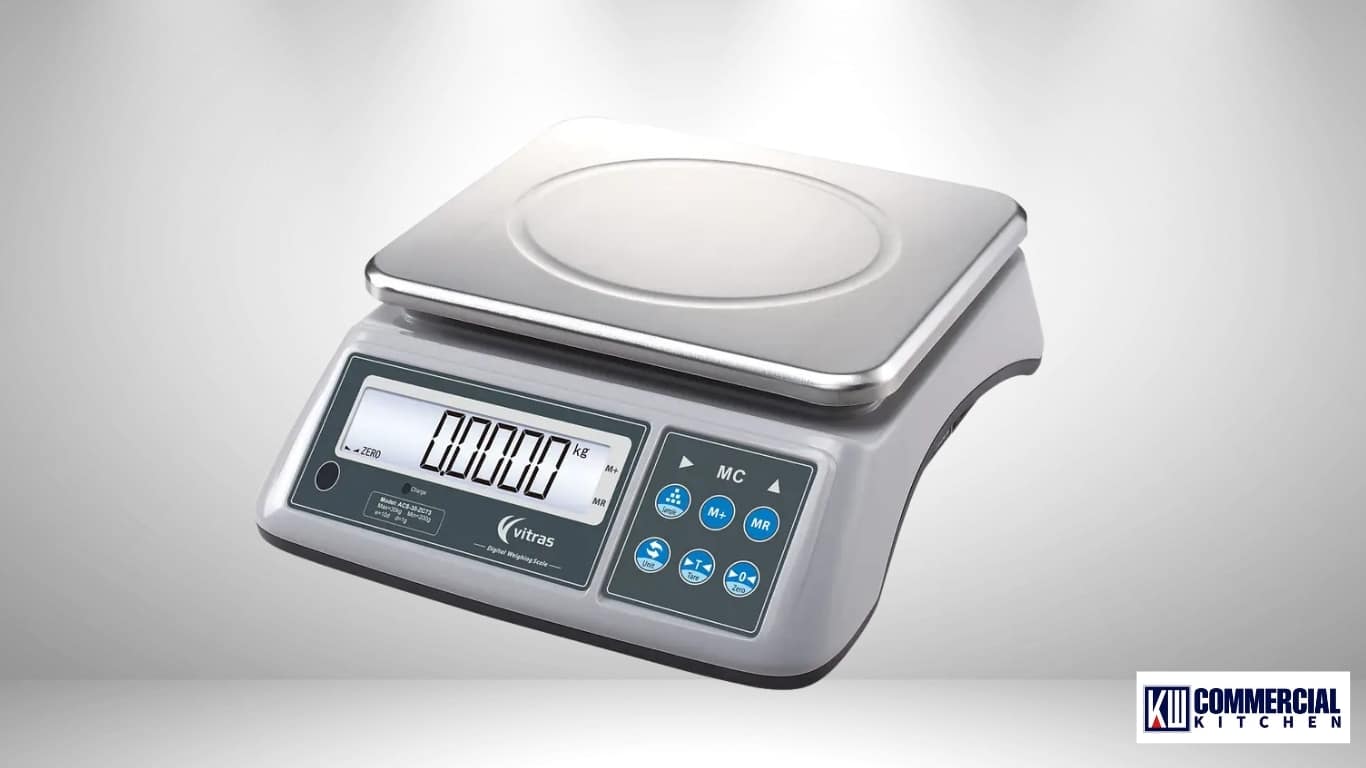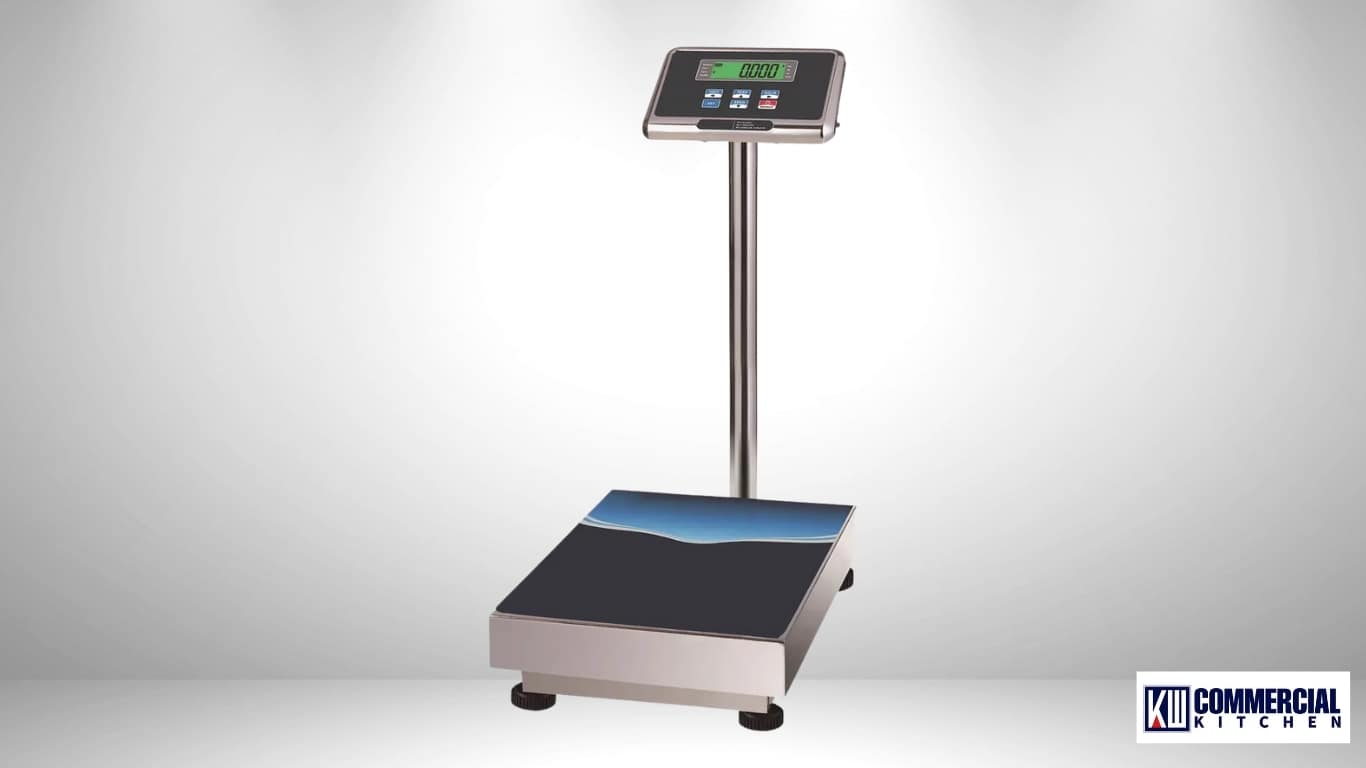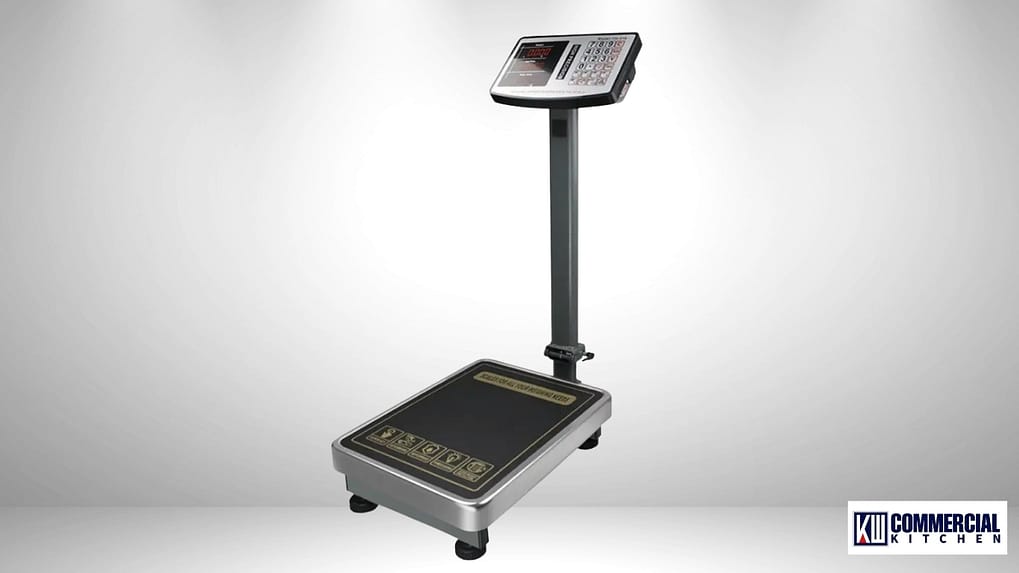The Professional Food Scale Guide for Australian Kitchens: Accuracy, Compliance & ROI
Stop using home scales. This is a no‑nonsense, Australia‑specific playbook that explains commercial vs home scales, how to spec capacity & readability, achieve a fast ROI through portion control, meet NMI/HACCP expectations, and keep your scales accurate with proper calibration & cleaning.
Author: KW Commercial Kitchen • Updated: • Category: Commercial Kitchen Scales
Definition (featured‑snippet ready): A food scale is a precision device that weighs ingredients or portions in grams/kilograms (and oz/lb) to control recipe accuracy, food cost and compliance; in commercial kitchens you match capacity to menu, choose the right readability, verify calibration, and clean to HACCP standards.
Executive TL;DR
- Commercial ≠ home: Stainless platforms, repeatability and service support matter more than cheapest price.
- Spec by task: 2 kg/0.1 g (pastry/coffee), 5 kg/1 g (line), 10 kg/1–2 g (wet prep), 30 kg/2–5 g (receiving).
- Compliance: If you sell by weight, choose a trade‑approved model (NMI). For kitchen portioning, focus on HACCP logging and verification.
- ROI: Tightening over‑serve by 2–5% typically pays a quality scale back in 1–3 months on busy lines.
- Calibration plan: Daily reference check; scheduled (preferably NATA‑traceable) calibration where critical.
Commercial vs Home Kitchen Scales: Why Your Business Can’t Risk the Wrong One
Search results for “food scale” are dominated by retail‑home products. In professional kitchens these devices often fail in weeks: benches vibrate, cleaning is wet, and lines move quickly. Here’s a side‑by‑side to set the record straight.
| Dimension | Commercial food scale | Home kitchen scale | Impact in a pro kitchen |
|---|---|---|---|
| Chassis & platform | Rigid frame, stainless platform; serviceable | Plastic body/platform | Flex → drift & inconsistent readings |
| Readability & repeatability | 0.1–2 g readability; fast stabilisation | 1–5 g; slow lock; more drift | Slower lines, training friction, waste |
| Ingress protection (IP) | IP65–IP68 options | Usually unrated | Wet cleaning kills home units |
| Compliance options | Trade‑approved (NMI) variants available | Not approved for trade | Illegal to sell by weight without approval |
| Workflow features | Check‑weigh lights, counting, %, negative tare | Basic weigh only | Slower, more errors, poor repeatability |
| Calibration & service | NATA‑traceable options; spares | Rare | No logs; downtime; early replacement |
| Total cost of ownership | Higher upfront, lower lifecycle cost | Low upfront, short lifespan | Commercial wins on ROI & reliability |
Scale Families & Where They Live in a Kitchen
| Use case | Typical capacity | Readability | Platform size | Key features |
|---|---|---|---|---|
| Pastry, barista, hydrocolloids | 2 kg | 0.1 g | Small | Timer, fast lock, % (baker’s), g/oz toggle |
| Line portioning (grill/salad) | 5 kg | 1 g | Medium | Check‑weigh lights, negative tare, mains power |
| Wet prep (seafood/meat) | 10 kg | 1–2 g | Medium | IP65+ sealed keypad/platform, easy clean |
| Receiving / batch | 30 kg | 2–5 g | Large | Sturdy platform, mains power, hold/stable |
Tip: choose the smallest capacity that safely covers your heaviest item—it yields better readability.

Every Gram Is Money: The ROI of Proper Portion Control
Two levers create ROI: tighter portions and faster training. A consistent 2–5% reduction in protein over‑serve on a busy line funds a commercial scale in weeks.
Mini Case Study — “The Daily Grind”, Sydney
- Replaced a $25 home scale with a rigid 2 kg/0.1 g commercial model on the coffee bar and a 5 kg/1 g check‑weigh unit on the line.
- Coffee dose variance dropped from ±1.5 g → ±0.2 g, saving ~3% beans.
- Protein portion variance fell by ~4–6 g per serve; fewer remakes, faster training.
- Annualised saving estimated at $4–6k; payback < 60 days.
Quick ROI Calculator
Use your numbers. The formula shows indicative savings from reducing over‑serve by reduction% (e.g., 60%).
| Item | Cost/serve | Target (g) | Typical drift | Covers/day | Days/mo | Monthly loss* | Saving @60% |
|---|---|---|---|---|---|---|---|
| Coffee dose | $0.45 | 18 | 1.0 g | 250 | 30 | $337.50 | $202.50 |
| Chicken breast | $2.10 | 150 | 6.0 g | 150 | 26 | $491.40 | $294.84 |
*Monthly loss = drift(g)/target(g) × cost/serve × covers/day × days/month.
Hidden costs that scales reduce
- Remakes and inconsistent cook times
- Negative reviews from portion inconsistency
- Training time for new staff
- Downtime from failed home‑grade scales
Specs Decoded: Buy Once, Buy Right
Capacity & readability pairs
Pick the smallest safe capacity for the task; it improves readability and stabilisation. On fast lines, favour mains power and disable aggressive auto‑off.
Repeatability vs accuracy
Repeatability (returning the same number for the same item) matters more day‑to‑day than a single absolute accuracy check. Stabilisation filters and rigid platforms drive repeatability.
Stabilisation & environment
- Place away from vents/fans; use anti‑vibration feet/mats.
- Allow warm‑up per the manual before verification or critical work.
Modes that save time
- Check‑weighing traffic‑light cues for line speed.
- Counting for prepping units (dumplings, cookies, lids).
- Percentage for baker’s formulas.
- Negative tare for weighing into containers.
IP ratings for cleaning
Choose IP65+ where wet cleaning is routine. Even IP‑rated units have limits—avoid pressure jets unless the specification explicitly allows it.
Australian Compliance: Trade Approval (NMI) & HACCP
- Trade‑approved (NMI) scale required when you sell by weight to customers (e.g., deli/retail). Use a pattern‑approved & verified instrument and keep verification seals intact.
- Kitchen portioning for HACCP usually does not need trade approval; focus on verification logs (daily checks) and scheduled calibration, preferably with NATA‑traceable certificates for critical processes.
- Confirm any local Council/State requirements for your food business and document procedures in your HACCP plan.
How to Verify & Calibrate a Food Scale (Daily + Scheduled)
- Stabilise the setup: Place the scale on a level, rigid bench away from vents/fans; fit anti‑vibration feet if needed.
- Warm‑up: Power on and wait the manufacturer’s warm‑up time (often a few minutes) for consistent readings.
- Zero & reference check: Zero the scale; place a protected reference weight (e.g., 1 kg). Confirm within the tolerance you’ve set (e.g., ±1 g on a 1 g‑readability scale).
- Out of tolerance? Perform the user calibration procedure in the manual. If readings remain out, book a service calibration (NATA‑traceable recommended for critical tasks) and mark the scale “pending calibration”.
- Log it: Record date, person, reference weight, reading, action in your HACCP verification log.
Keep reference weights clean, dry and protected; avoid touching weights with bare hands to prevent oils changing mass.
How to Clean a Food Scale Daily (Without Damaging It)
- Power & prep: Turn off/unplug. Remove the platform only if designed for removal.
- Wash: Wipe with warm water + mild detergent on a damp cloth. Do not immerse.
- Rinse & sanitise: Rinse cloth; wipe; apply food‑safe sanitiser. Avoid soaking keypads or seams.
- Dry & reassemble: Dry thoroughly; refit parts; power on and re‑check zero.
- Weekly: Inspect feet/level, check battery health, perform a drift check with your reference weight.
For IP‑rated models (IP65+), follow the brand’s specific limits; pressure jets are usually disallowed unless expressly stated.

Environment & Troubleshooting
| Symptom | Likely cause | Quick fix |
|---|---|---|
| Readout drifts | Airflow or vibration | Move away from vents; stabilise feet; add an anti‑vibration mat |
| Won’t zero | Residue on platform; tare stuck | Clean platform, remove loads; reset tare; reboot |
| Random shutdown | Auto‑off; battery low | Use mains power; extend auto‑off; replace/recharge batteries |
| Water ingress | Over‑wet cleaning beyond rating | Dry thoroughly; book service; spec an IP‑rated model for wet work |
After‑Sale Ecosystem: Calibration, Service & Lifecycle
- Internal vs NATA‑traceable calibration: daily checks in‑house; schedule external calibration for critical weights/processes.
- Serviceability & parts: select models with local parts availability and a service network; ask about loan units to avoid downtime.
- Lifecycle management: plan for multi‑year use; upgrade when capacity, IP rating or connectivity requirements shift.
Future‑Ready Kitchens: Connectivity & System Integration
Some commercial scales offer USB/serial/CSV exports, check‑weigh buzzers and light towers, or integration to inventory/POS. If you run multi‑site operations, log data centrally to reduce manual entry and errors.
Quick Picks & Buyer’s Checklist
Quick picks (by venue & task)
- Café/pastry: 2 kg/0.1 g, timer, fast‑lock, compact platform.
- Burger/line: 5 kg/1 g, check‑weigh lights, mains power, negative tare.
- Seafood/meat (wet): 10 kg/1–2 g, IP65+ sealed keypad/platform.
- Receiving: 30 kg/2–5 g, large platform, hold/stable, mains power.
Final buying checklist
- Primary use‑case and capacity/readability pair
- Platform size & rigidity; stabilisation time
- IP rating & cleanability (wet work?)
- Modes: check‑weigh, %, counting, negative tare
- Power & auto‑off behaviour (line use)
- Need trade‑approved (NMI)? (retail sales by weight)
- Calibration/verification plan; service network & spares
Food Scale — Frequently Asked Questions
What capacity and readability should a food scale have for cooking?
For pastry/coffee use 2 kg with 0.1 g readability; general line portioning 5 kg/1 g; wet prep 10 kg/1–2 g; receiving 30 kg/2–5 g. Pick the smallest safe capacity to get faster, more stable readings.
Do I need a trade‑approved scale?
Only if you sell by weight to customers. Then select a pattern‑approved and verified model (NMI). For back‑of‑house portioning, concentrate on HACCP verification and scheduled calibration.
How often should I calibrate a food scale?
Do a daily reference check in‑house and schedule external calibration based on risk and usage. For critical processes, a NATA‑traceable certificate is recommended.
Are waterproof food scales really waterproof? What is IP65?
IP65 means dust‑tight and protected from low‑pressure water jets. It doesn’t guarantee immersion safety. Always follow the manufacturer’s specific cleaning limits.
Why does my scale drift or fail to zero?
Common causes are airflow, vibration, bench flex, residue on the platform, or auto‑tare/zero settings. Stabilise the bench, clean the platform, reset tare and re‑check with a reference weight.
Can one scale do both precision pastry and line portioning?
In practice you’ll be faster and more consistent with two devices: 2 kg/0.1 g for precision; 5–10 kg with check‑weigh lights for the line.
What’s the difference between accuracy and repeatability?
Accuracy is closeness to true value; repeatability is getting the same reading when weighing the same thing repeatedly. In daily kitchen use, repeatability drives consistency and labour speed.

